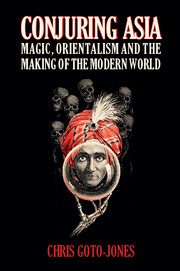6 - Japanese magic and magic in Japan
from Part II
Published online by Cambridge University Press: 05 July 2016
Summary
Japanese magic
The mysteriousness of Japan in the Western imagination was already firmly embedded before the middle of the nineteenth century. This was partially because of its extreme distance from Europe and the haziness of distant geography at the time. It was partly because of a general confusion about the perceived difference, if any, between China and Japan. But it was largely because Japan's official policy of sakoku – isolationism – had severely restricted the flow of information and commerce between Japan and the Western world. Although sakoku was far from watertight, it was a sufficient deterrent to make it unlikely that European powers would make the extra effort of travelling into the far, Far East, when India and China were open for business en route. Before the westward expansion of the United States reached California in the mid-1800s, there was very little chance that anyone would approach the Japanese islands from the east. Hence, Japan was mysterious largely because of Western ignorance about it, which made it fertile ground for the fantastical and magical imagination.
In fact, Jonathan Swift (1667–1745) famously included Japan as one of the fantastical lands in part three of Gulliver's Travels (1726/35). Gulliver finds Japan just to the west of Lugnagg and Glubbdubdrib, which is a land filled with necromancers, sorcerers, and magicians, but he notes with some resentment that only the Dutch were allowed to land there. Swift was correct that the Dutch maintained a small trading port near Nagasaki – the islet of Deshima – and the Netherlands was the only European nation permitted to trade with Japan, albeit with strict prohibition against any incursions onto any of the main Japanese islands.
Hence, it was not until after the forced opening of Japan in 1854 that the populations of Western nations really became able to access information about the distant empire or actually to see Japanese people. Even so, until at least the Meiji Restoration in 1868, access to the cities and interior of Japan was still very restricted: foreigners were limited to the international zones of port cities like Kobe and Yokohama. At the same time, Japanese subjects were not formally permitted to leave the country unless they were on official diplomatic missions.
- Type
- Chapter
- Information
- Conjuring AsiaMagic, Orientalism and the Making of the Modern World, pp. 265 - 303Publisher: Cambridge University PressPrint publication year: 2016



